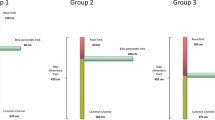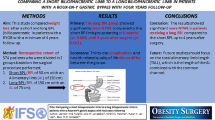Abstract
Background
The best alimentary and biliopancreatic limb (BPL) lengths in the Roux-en-Y gastric bypass (RYGB) still remain unclear. The aim of this study was to compare the effect of a BPL of 70 vs 120 cm, with a constant AL of 150 cm on long-term weight loss, remission of comorbidities, and supplementation needs after RYGB.
Patients and Methods
A prospective randomized study of morbidly obese patients undergoing RYGB was performed. Patients were randomized into two groups: those patients undergoing RYGB with a BPL of 70 cm (BPL 70 cm) and those ones undergoing RYGB with a BPL of 120 cm (BPL 120 cm). BMI, excess BMI loss (EBMIL), remission of comorbidities and specific vitamin and mineral supplementation needs at 1, 2, and 5 years were analyzed.
Results
Two hundred fifty-three patients were included in each group. There were no significant differences in BMI, EBMIL and the remission of diabetes mellitus, hypertension, and dyslipidemia between groups at 1, 2, and 5 years after surgery. Patients from group BPL 120 cm required greater specific supplementation of vitamin B12, folic acid, and vitamin A during all the follow-up.
Conclusion
A RYGB with 120 cm BPL does not achieve greater weight loss or remission of comorbidities than a RYGB with 70 cm BPL but is associated with greater deficiencies of vitamin B12, vitamin A, and folic acid.
Trial Registration
ClinicalTrials.gov Identifier NCT03607305. https://clinicaltrials.gov/.
Similar content being viewed by others
References
Schauer PR, Kashyap SR, Wolski K, et al. Bariatric surgery versus intensive medical therapy in obese patients with diabetes. N Engl J Med. 2012;366:1567–76.
Mason EE, Ito C. Gastric bypass. Ann Surg. 1969;170:329–39.
Madan AK, Harper JL, Tichansky DS. Techniques of laparoscopic gastric bypass: on-line survey of American Society for Bariatric Surgery practicing surgeons. Surg Obes Relat Dis. 2008;4:166–72.
Elder KA, Wolfe BM. Bariatric surgery: a review of procedures and outcomes. Gastroenterology. 2007;132:2253–71.
Higa K, Ho T, Tercero F, et al. Laparoscopic Roux-en-Y gastric bypass: 10-year follow-up. Surg Obes Relat Dis. 2011;7:516–25.
Tacchino RM. Bowel length: measurement, predictors and impact on bariatric and metabolic surgery. Surg Obes Relat Dis. 2015;11:328–34.
Stefanidis D, Kuwada TS, Gersin KS. The importance of the length of the limbs for gastric bypass patients–an evidence-based review. Obes Surg. 2011;21:119–24.
Mahawar KK, Kumar P, Parmar C, et al. Small bowel limb lenghts and Roux-en-Y gastric bypass: a systematic review. Obes Surg. 2016;26:660–71.
Rubino F, Gagner M, Gentileschi P, et al. The early effect of the roux-en-Y gastric bypass on hormones involved in body weight regulation and glucose metabolism. Ann Surg. 2004;240:236–42.
Christou NV, Look D, Maclean LD. Weight gain after short- and long-limb gastric bypass in patients followed for longer than 10 years. Ann Surg. 2006;244:734–40.
Suter M, Calmes JM, Paroz A, et al. Results of Roux-en-Y gastric bypass in morbidly obese vs superobese patients: similar body weight loss, correction of comorbidities, and improvement of quality of life. Arch Surg. 2009;144:312–8.
Mumphrey MB, Patterson LM, Zheng H, et al. Roux-en-Y gastric bypass surgery increases number but not density of CCK-, GLP-1-, 5-HT-, and neurotensin-expressing enteroendocrine cells in rats. Neurogastroenterol Motil. 2013;25:e70–9.
Stefanidis D, Kuwada TS, Gersin KS. The importance of the length of the limbs for gastric bypass patients—an evidence-based review. Obes Surg. 2011;21:119–24.
Navez B, Thomopoulos T, Stefanescu I, et al. Common limb length does not influence weight loss after standard laparoscopic Roux-en-Y gastric bypass. Obes Surg. 2016;26:1705–9.
Papadia F. Effect of standard versus extended Roux limb length on weight loss outcomes after laparoscopic Roux-en-Y gastric bypass. Surg Endosc. 2004;18:1683.
Nergaard BJ, Leifsson BG, Hedenbro J, et al. Gastric bypass with long alimentary limb or long pancreato-biliary limb—long-term results on weight loss, resolution of co-morbidities and metabolic parameters. Obes Surg. 2014;24:1592–602.
Karra E, Yousseif A, Batterham RL. Mechanisms facilitating weight loss and resolution of type 2 diabetes following bariatric surgery. Trends Endocrinol Metab. 2010;21:337–44.
Beckman LM, Beckman TR, Earthman CP. Changes in gastrointestinal hormones and leptin after roux-en-Y gastric bypass procedure: a review. J Am Diet Assoc. 2010;110:571–84.
Konturek PC, Konturek JW, Cześnikiewicz-Guzik M, et al. Neuro-hormonal control of food intake: basic mechanisms and clinical implications. J Physiol Pharmacol. 2005;56:5–25.
Mahawar KK, Kumar P, Parmar C, et al. Small bowel limb lengths and Roux-en-Y gastric bypass: a systematic review. Obes Surg. 2016;26:660–71.
Mechanick JI, Youdim A, Jones DB, et al. Clinical practice guidelines for the perioperative nutritional, metabolic, and nonsurgical support of the bariatric surgery patient—2013 update: cosponsored by American Association of Clinical Endocrinologists, the Obesity Society, and American Society for Metabolic & Bariatric Surgery. Surg Obes Relat Dis. 2013;9:159–91.
Author information
Authors and Affiliations
Corresponding author
Ethics declarations
Conflict of Interest
The authors declare that they have no conflict of interest.
Statement of Informed Consent
Informed consent was obtained from all individual participants included in the study.
Statement of Human Rights
All procedures performed in this study were in accordance with the ethical standards of the institutional research committee and with the 1964 Helsinki declaration and its later amendments.
Additional information
Publisher’s Note
Springer Nature remains neutral with regard to jurisdictional claims in published maps and institutional affiliations.
Rights and permissions
About this article
Cite this article
Ruiz-Tovar, J., Vorwald, P., Gonzalez-Ramirez, G. et al. Impact of Biliopancreatic Limb Length (70 cm vs 120 cm), with Constant 150 cm Alimentary Limb, on Long-Term Weight Loss, Remission of Comorbidities and Supplementation Needs After Roux-En-Y Gastric Bypass: a Prospective Randomized Clinical Trial. OBES SURG 29, 2367–2372 (2019). https://doi.org/10.1007/s11695-019-03717-7
Published:
Issue Date:
DOI: https://doi.org/10.1007/s11695-019-03717-7




